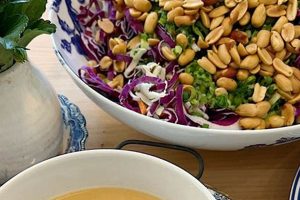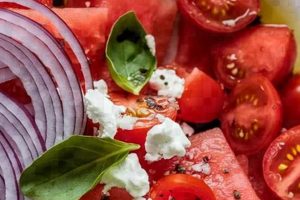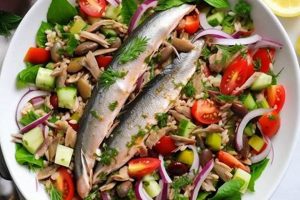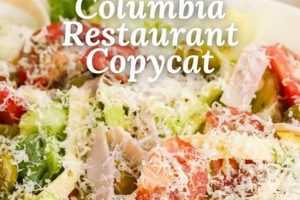Crisp, refreshing, and often vibrant in color, salads featuring cabbage prepared with Asian-inspired dressings and ingredients represent a diverse culinary landscape. These preparations can range from light and tangy slaws featuring shredded Napa cabbage to more substantial salads incorporating other vegetables, proteins, and nuts. Examples include kimchi slaw, sesame ginger salads with shredded carrots and edamame, and crunchy peanut salads with Chinese cabbage.
Such salads offer a healthy and flavorful way to incorporate a variety of vegetables into one’s diet. Cabbage, a cruciferous vegetable, is rich in vitamins, minerals, and fiber, contributing to digestive health and overall well-being. The diverse range of flavor profiles offered through the integration of ingredients like soy sauce, sesame oil, rice vinegar, ginger, garlic, and chili peppers provides a compelling alternative to traditional Western-style salads. These flavor combinations reflect centuries of culinary tradition in various Asian countries, each contributing unique nuances and ingredients.
The subsequent sections will delve deeper into specific regional variations, exploring the diverse ingredients, techniques, and cultural influences that shape these culinary creations. Nutritional information and practical tips for preparation and storage will also be provided.
Tips for Preparing Cabbage Salads
Achieving optimal flavor and texture in cabbage salads requires attention to detail throughout the preparation process. The following tips offer guidance for creating delicious and satisfying results.
Tip 1: Cabbage Selection: Different cabbage varieties offer distinct textures and flavors. Napa cabbage provides a delicate, slightly sweet flavor, while regular green cabbage offers a more robust, peppery taste. Consider the desired flavor profile when selecting the cabbage.
Tip 2: Slicing Techniques: Thinly slicing or shredding the cabbage is crucial for achieving a pleasant texture. Mandolines or sharp knives create uniform pieces, ensuring even coating with dressings and a consistent eating experience.
Tip 3: Salting and Massaging: Salting the cabbage and gently massaging it for a few minutes helps to soften the leaves and draw out excess moisture, preventing a watery salad. This step also contributes to a more tender texture.
Tip 4: Dressing Emulsification: Proper emulsification of the dressing ensures that the oil and acidic components combine effectively, creating a smooth and flavorful coating for the cabbage and other ingredients.
Tip 5: Ingredient Balance: Balancing sweet, sour, salty, and spicy elements is essential for a well-rounded flavor profile. Taste and adjust seasonings throughout the preparation process.
Tip 6: Freshness and Storage: Using fresh, high-quality ingredients is paramount. Store prepared salads in airtight containers in the refrigerator for optimal freshness. Consume within two to three days.
Tip 7: Garnishes and Texture: Enhance visual appeal and textural complexity by incorporating garnishes such as toasted sesame seeds, chopped peanuts, crispy noodles, or fresh herbs like cilantro or mint.
By following these guidelines, one can consistently create flavorful and satisfying cabbage salads that showcase the versatility of this humble vegetable.
These insights into preparation techniques and ingredient selection provide a foundation for exploring a world of flavorful possibilities.
1. Cabbage Variety
Cabbage variety plays a crucial role in determining the texture, flavor profile, and overall aesthetic of Asian cabbage salads. The choice of cabbage significantly influences the final dish, affecting how it interacts with the dressing and other ingredients. Understanding the characteristics of different cabbage varieties allows for informed decisions when creating these salads.
- Napa Cabbage:
Known for its oblong shape and tender, slightly sweet leaves, Napa cabbage is a popular choice for salads requiring a delicate texture. Its mild flavor complements a wide range of dressings and readily absorbs flavors. It is frequently used in kimchi and various other Asian slaws.
- Chinese Cabbage (Bok Choy):
Characterized by its crunchy stalks and dark green leaves, bok choy offers a more substantial texture and slightly bitter flavor. While often used in stir-fries, its crunchy texture can also add depth to salads, particularly those with bolder dressings. Baby bok choy, with its smaller size and more tender leaves, is also a suitable option.
- Red Cabbage:
Adding a vibrant pop of color, red cabbage offers a slightly peppery flavor and crisp texture. It holds its shape well in salads and provides a beautiful contrast to other ingredients. Its robust flavor pairs well with tangy and slightly sweet dressings.
- Green Cabbage:
Commonly found in Western cuisine, green cabbage can also be incorporated into Asian-inspired salads. It has a denser texture and more pronounced peppery flavor compared to Napa cabbage. Its affordability and availability make it a versatile option.
The selection of a specific cabbage variety significantly impacts the final salad’s character. Consider the desired texture and flavor profile when choosing a cabbage, ensuring it complements the other ingredients and the overall balance of the dish. From the delicate sweetness of Napa cabbage to the peppery bite of red cabbage, the chosen variety provides a foundation upon which a diverse range of Asian-inspired salads can be built.
2. Dressing Flavors
Dressing flavors constitute a defining characteristic of Asian cabbage salads, contributing significantly to their diverse and vibrant character. The interplay of sweet, sour, salty, spicy, and umami elements creates a complex flavor profile that elevates the simple cabbage base. These flavors not only enhance the palatability of the salad but also reflect specific cultural influences and regional variations. The careful balance of these elements is crucial for achieving a harmonious and satisfying culinary experience.
Common components of Asian salad dressings include soy sauce, rice vinegar, sesame oil, ginger, garlic, chili flakes, and fish sauce. Soy sauce provides a salty and umami base, while rice vinegar introduces a tangy acidity. Sesame oil adds a nutty aroma and richness, while ginger and garlic contribute pungent notes. Chili flakes introduce varying levels of heat, while fish sauce, commonly used in Southeast Asian cuisine, imparts a distinct savory depth. Variations in the proportions and combinations of these ingredients give rise to a wide spectrum of dressing flavors, each reflecting unique culinary traditions. For example, a Korean kimchi slaw might feature a fiery gochujang-based dressing, while a Japanese seaweed salad might incorporate a lighter, sesame-ginger vinaigrette.
Understanding the role of dressing flavors is essential for appreciating the complexity and diversity of Asian cabbage salads. The careful selection and balance of ingredients contribute not only to taste but also to texture and overall appeal. Whether it’s the bright, citrusy notes of a Thai-inspired dressing or the deep, savory flavors of a Vietnamese dipping sauce, the dressing serves as the unifying element that transforms simple ingredients into a cohesive and flavorful dish. Furthermore, understanding these flavor profiles allows for greater culinary creativity, enabling adaptation and experimentation with different ingredient combinations and regional influences.
3. Additional Ingredients
Additional ingredients in Asian cabbage salads contribute significantly to textural complexity, flavor enhancement, and nutritional value. These additions move beyond the foundational cabbage and dressing, creating a more substantial and satisfying dish. The careful selection of complementary ingredients elevates the salad from a simple side dish to a complete meal, offering a balanced nutritional profile and a more engaging culinary experience. The interplay of flavors and textures from these additions enhances the overall complexity and enjoyment of the salad.
Common additions include proteins, vegetables, nuts, seeds, and crunchy elements. Proteins such as grilled chicken, shrimp, or tofu provide substance and satiety. A variety of vegetables, including shredded carrots, edamame, bell peppers, and cucumbers, introduce contrasting textures and flavors. Nuts and seeds, such as toasted sesame seeds, chopped peanuts, or slivered almonds, contribute healthy fats, protein, and textural contrast. Crunchy elements like crispy noodles or wonton strips provide an appealing textural counterpoint to the softer cabbage. For instance, a Thai-inspired cabbage salad might incorporate shredded chicken, chopped peanuts, and fresh cilantro, while a Korean kimchi slaw might feature toasted sesame seeds and scallions.
The strategic inclusion of these additional ingredients expands the culinary possibilities of Asian cabbage salads, offering a versatile platform for creative expression. The balance of flavors, textures, and nutritional elements contributes not only to taste and enjoyment but also to the overall healthfulness of the dish. Understanding the role and impact of these additions empowers individuals to customize salads according to personal preferences and dietary needs, creating a truly bespoke culinary experience.
4. Cultural Influences
Cultural influences significantly shape the diverse landscape of Asian cabbage salads, impacting ingredient selection, flavor profiles, and preparation techniques. These culinary traditions reflect regional variations and historical contexts, resulting in a wide array of unique and flavorful dishes. Exploring these cultural nuances provides a deeper understanding and appreciation of the rich heritage associated with these salads.
- Korean Cuisine:
Kimchi, a staple of Korean cuisine, exemplifies the cultural significance of fermented cabbage. The spicy, pungent flavors derived from gochujang, garlic, ginger, and other spices reflect Korean culinary preferences. Kimchi often serves as a base for salads, incorporating other ingredients like tofu, noodles, or seafood, showcasing the versatility of this fermented cabbage preparation.
- Japanese Cuisine:
Japanese cabbage salads often emphasize lighter, more delicate flavors. Ingredients like shredded Napa cabbage, seaweed, and sesame-ginger dressings are common, reflecting a preference for fresh, seasonal ingredients and balanced flavor profiles. The emphasis on presentation and minimalist aesthetics also plays a significant role in Japanese culinary traditions, influencing the visual appeal of these salads.
- Southeast Asian Cuisine:
Southeast Asian cabbage salads frequently incorporate fresh herbs, such as cilantro, mint, and basil, along with ingredients like fish sauce, lime juice, and chilies. These vibrant and flavorful salads often feature shredded green cabbage, carrots, and peanuts, reflecting the region’s abundant use of fresh produce and bold flavor combinations.
- Chinese Cuisine:
Chinese cabbage salads showcase a variety of regional influences, ranging from Sichuan’s spicy flavors to Cantonese cuisine’s emphasis on fresh, light dishes. Ingredients like shredded cabbage, wood ear mushrooms, and sesame oil are common, often combined with flavorful sauces and dressings that balance sweet, sour, and savory elements.
These diverse cultural influences highlight the rich tapestry of Asian cabbage salad traditions. From the fiery kimchi of Korea to the delicate flavors of Japan, each culinary tradition offers a unique perspective on the versatile cabbage. Understanding these cultural nuances provides valuable insights into the historical and regional contexts that have shaped these diverse and flavorful dishes, allowing for greater appreciation of their culinary significance.
5. Preparation Techniques
Preparation techniques significantly influence the final texture, flavor, and overall quality of Asian cabbage salads. Proper execution of these techniques ensures optimal results, maximizing the potential of the ingredients and creating a more enjoyable culinary experience. These techniques, often specific to regional traditions, contribute to the distinct characteristics of various Asian cabbage salads, highlighting the importance of precision and attention to detail throughout the preparation process.
- Slicing and Shredding:
Precise slicing and shredding techniques determine the texture and how the cabbage interacts with the dressing. Thinly sliced cabbage offers a delicate texture and readily absorbs flavors, while thicker cuts provide more crunch. Uniformity in size ensures even coating with the dressing and consistent texture throughout the salad. For example, finely shredded Napa cabbage is ideal for kimchi, while thicker slices of Chinese cabbage might be used in a stir-fried salad.
- Salting and Massaging:
Salting and massaging cabbage draws out excess moisture, preventing a watery salad and contributing to a more tender texture. This process also helps to season the cabbage, enhancing its flavor. The amount of salt and massaging time vary depending on the cabbage variety and desired outcome. For instance, Napa cabbage might require less salting and massaging compared to denser varieties like green cabbage.
- Dressing Application:
The timing and method of dressing application impact the final flavor and texture of the salad. Adding the dressing just before serving prevents the cabbage from becoming soggy, maintaining its crispness. Some recipes call for marinating the cabbage in the dressing for a more intense flavor infusion, while others recommend a light coating just before serving to preserve texture. The choice depends on the specific salad and desired outcome.
- Ingredient Incorporation:
The order and method of incorporating additional ingredients affect the balance of flavors and textures. Adding delicate ingredients like fresh herbs towards the end prevents them from wilting, while heartier ingredients like nuts or proteins can be incorporated earlier. Understanding the properties of each ingredient and how it interacts with the dressing and other components ensures a harmonious and well-balanced salad.
Mastery of these preparation techniques elevates Asian cabbage salads from simple to exceptional. Precise slicing, careful salting, strategic dressing application, and thoughtful ingredient incorporation contribute to the overall quality and enjoyment of the dish. These techniques, often passed down through generations, reflect the culinary wisdom and attention to detail that characterize many Asian culinary traditions, demonstrating the crucial link between preparation and the final product.
6. Nutritional Benefits
Asian cabbage salad recipes offer a wealth of nutritional benefits, stemming from the inherent properties of cabbage and the diverse array of ingredients commonly incorporated. These salads contribute significantly to a healthy and balanced diet, providing essential vitamins, minerals, fiber, and antioxidants. Understanding these nutritional advantages further underscores the value of incorporating these dishes into regular meal planning.
- Vitamins and Minerals:
Cabbage is a rich source of vitamins C and K, both crucial for various bodily functions. Vitamin C supports immune function and collagen production, while vitamin K plays a vital role in blood clotting and bone health. Asian cabbage salads often include other vitamin-rich vegetables like carrots (vitamin A) and bell peppers (vitamin C), further enhancing their nutritional value. The inclusion of ingredients like sesame seeds or nuts also contributes minerals such as calcium, magnesium, and zinc.
- Fiber Content:
Cabbage is an excellent source of dietary fiber, promoting digestive health and regularity. Fiber adds bulk to the diet, aiding in satiety and contributing to healthy weight management. The inclusion of other fiber-rich vegetables and ingredients like edamame further enhances the fiber content of these salads, supporting overall digestive well-being.
- Antioxidant Properties:
Cabbage contains antioxidants, including glucosinolates, which are associated with various health benefits, including reduced inflammation and potential cancer-protective effects. These compounds contribute to the overall health-promoting properties of Asian cabbage salads. Ingredients like ginger and garlic, often incorporated into dressings, also possess antioxidant properties, further enhancing the protective benefits.
- Low Calorie Density:
Asian cabbage salads are typically low in calories, making them a suitable choice for those seeking to manage their weight. The high water and fiber content contributes to satiety without adding excessive calories. The use of light and flavorful dressings, rather than heavy, calorie-dense alternatives, further contributes to the low-calorie nature of these dishes.
The nutritional advantages of Asian cabbage salads extend beyond basic sustenance, contributing to overall health and well-being. The combination of vitamins, minerals, fiber, antioxidants, and low-calorie density makes these salads a valuable addition to any diet. By incorporating a variety of fresh ingredients and flavorful dressings, these dishes offer a delicious and nutritious way to support a healthy lifestyle. Furthermore, the versatility of these salads allows for adaptation to individual dietary needs and preferences, making them a sustainable and enjoyable component of a balanced diet.
Frequently Asked Questions
This section addresses common inquiries regarding Asian cabbage salads, providing concise and informative responses to clarify potential uncertainties and enhance understanding of these versatile dishes.
Question 1: How long can prepared Asian cabbage salad be stored in the refrigerator?
Prepared salads are best consumed within two to three days for optimal quality and food safety. Storage in airtight containers helps to maintain freshness and prevent spoilage.
Question 2: Can different types of cabbage be used interchangeably in these recipes?
While some flexibility exists, different cabbage varieties offer distinct textures and flavors. Substituting one type for another may alter the final dish’s characteristics. Recipe adaptation may be necessary to account for these differences.
Question 3: What are some suitable protein additions for a more substantial salad?
Grilled chicken, shrimp, tofu, or edamame are excellent protein additions, contributing to satiety and nutritional value. The choice of protein can be tailored to dietary preferences and regional culinary traditions.
Question 4: How can the spiciness level be adjusted in these salads?
The amount of chili flakes, chili garlic sauce, or other spicy ingredients can be adjusted to suit individual preferences. Starting with a smaller amount and gradually increasing it allows for customized heat levels.
Question 5: Are Asian cabbage salads suitable for individuals with dietary restrictions?
Many Asian cabbage salads can be adapted to accommodate dietary restrictions. Gluten-free versions can be created by using tamari or coconut aminos in place of soy sauce. Vegan options can be achieved by omitting animal-based proteins and ensuring other ingredients align with vegan dietary guidelines. Careful ingredient selection allows for customization to meet specific dietary needs.
Question 6: What are some common mistakes to avoid when preparing these salads?
Overdressing the salad can lead to a soggy texture. Adding the dressing just before serving helps maintain crispness. Over-massaging the cabbage can also result in a less desirable texture. Using fresh, high-quality ingredients is crucial for optimal flavor and texture.
Understanding these common inquiries provides a solid foundation for successful preparation and enjoyment of Asian cabbage salads. Careful consideration of these points allows for greater flexibility and customization, ensuring a satisfying culinary experience.
This concludes the frequently asked questions section. Further exploration of specific regional variations and recipe examples follows.
Asian Cabbage Salad Recipes
This exploration of Asian cabbage salad recipes has highlighted the diversity and versatility inherent in this culinary category. From the delicate textures of Napa cabbage to the robust flavors of kimchi, the spectrum of ingredients, preparation techniques, and cultural influences contributes to a rich tapestry of culinary possibilities. The examination of core components, including cabbage varieties, dressing flavors, additional ingredients, and regional variations, underscores the complexity and depth of these seemingly simple dishes. Furthermore, the discussion of preparation techniques and nutritional benefits emphasizes the importance of both culinary skill and nutritional awareness in creating healthy and flavorful meals.
The adaptability of Asian cabbage salads to diverse dietary needs and culinary preferences positions them as a valuable component of a modern, health-conscious approach to eating. Continued exploration of regional variations and creative ingredient combinations promises further culinary discoveries, ensuring that Asian cabbage salad recipes remain a vibrant and evolving element of global gastronomy. The potential for innovation within this culinary space remains vast, inviting further exploration and appreciation of the versatile cabbage.






